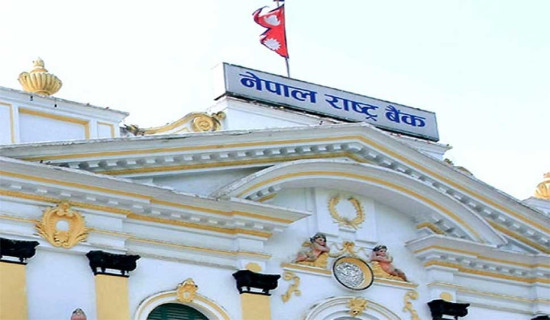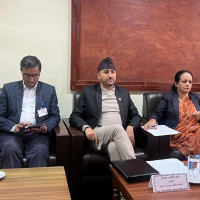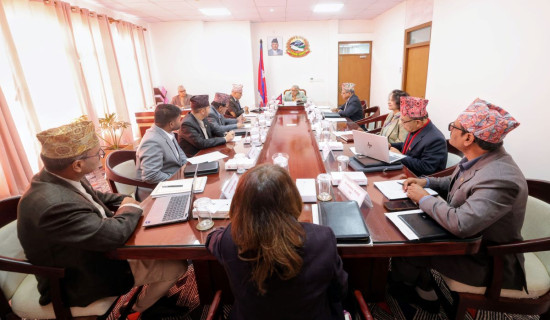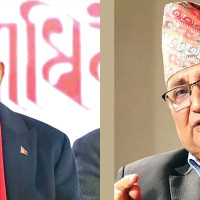- Tuesday, 16 December 2025
The Unmet Objectives Of Bank Mergers
Globally, there are ample cases of mergers of banking and financial institutions (BFIs) – from JP Morgan Chase & Co. and Bank One Corporation to Bank of America and Merrill Lynch. But, they were all voluntary desires of the banks. In neighbouring India, the merger of big banks like Punjab National Bank and Indian Bank, or the merging of Union Bank of India with other smaller banks have had positive impacts, consolidating their strength, creating synergic effect and benefitting both investors and customers. Researchers at Reserve Bank of India (RBI) also found that bank mergers in that country have not only benefitted the banking sector but also there have been improvements in financial performance and efficiency of the merged banks.
Probably, inspired by this scenario, Nepal Rastra Bank (NRB) came up with a merger policy - not only to cut down the sizes of banks but also to make the whole banking system stronger. They then introduced the Bank's Merger and Acquisition Bylaws in 2073, which was the reason why banks in Nepal went through a series of merger and acquisition procedures. The bylaws had set clearly defined objectives for pushing BFI's merger which included preservation of financial institutions for promoting the trustworthiness of banks. There were objectives set for the merger regarding the creation of safe, secure, healthy, and capable financial sectors. From the rise of the capital base rate and rising competition to the creation of advanced, quality-filled banking facilities, the bylaws had the objective of meeting the requirements of depositors, investors, and everyone associated.
Reality
Ideas look good in words, and in policies, but can differ in reality. After almost eight years of introduction of the bylaws and with all the pressure-filled merger campaigns that the NRB had in the last few years, there are 20 commercial banks, 17 development banks, 17 finance companies, 57 micro finance and 1 infrastructure development bank in existence as of Poush 2080, making a total of 112 licensed BFIs. The numbers have fallen after the merger and acquisition campaign brought by the central bank. But the question remains: Did the merger meet its objective? Was it beneficial for the economy? There was not any significant measure or impact identified regarding investments after the merger. The number of loans that BFI disbursed increased from 2903588.2 million in 2020 to 4315377.0 million in 2023. There has been a rise but this does not imply the rise because of a merger, but simply a gradual inclination, which, if the trend is seen - would remain even without the merger process being conducted.
There has not been any diversification in investment areas as a consequence of the merger. Banks are lending in similar sectors - real estate, vehicles, industries, etc. in the same pattern as earlier. There has not been any notable impact in the non-funded sector either. The big mergers that took place in the last few years did not bring any notable impact on the informal economy either - there still exists a similar pattern of hundi trend here. Neither has financial access been easy as a consequence of the merger because the footsteps in the banking door are the same that used to be in two different banks earlier.
There has not been any impact on liquidity, because the ups and downs of liquidity are because of market consequences, central bank policies, and government decisions. There is nothing to be counted as a result of the merger. Neither has the economy been impacted because of all these merger campaigns. Rather, financial frauds have increased in number. The number of banking frauds and digital frauds has risen. There has been a huge cut-off of employees as a consequence of the merger. Thousands of youths who were dependent on job opportunities provided by banks have lost their job and are compelled to fly abroad. From top-level managers to junior assistants, they and their families had to suffer. A young student dreaming of a banking job had to shift their dream to third-world nations, all because of the merger.
Trustworthiness
Indeed, things rather turned out to be more complicated because of the merger. Evaluating the objectives set by the central bank, the merger seriously did not play any role in enhancing the trustworthiness of the bank. People haven't been safe from loan sharks. With increasingly fraudulent cases from ATM hacks to online frauds, neither could financial institutions assure healthy and secure financial practices. The competition rather remained only in snatching one customer from others, whether depositors or creditors. There has been no healthy competition.
With different rumours, the level of trustworthiness towards the banking system has been in decline in recent days, bringing into question the credibility and integrity of the whole banking system. All the six objectives certainly did not meet their objective, clearly indicating the failure of the whole master plan. The merger was supposed to introduce a synergic effect among banks, which did not happen in reality. Merger itself is a strong policy, but forceful mergers should not have been imposed. Instead, voluntary mergers should have been promoted for the benefit of the whole economy. The whole plan as of now seems baseless anyway.
(Regmi is a Deputy Manager at Rastriya Banijya Bank Ltd.)

















